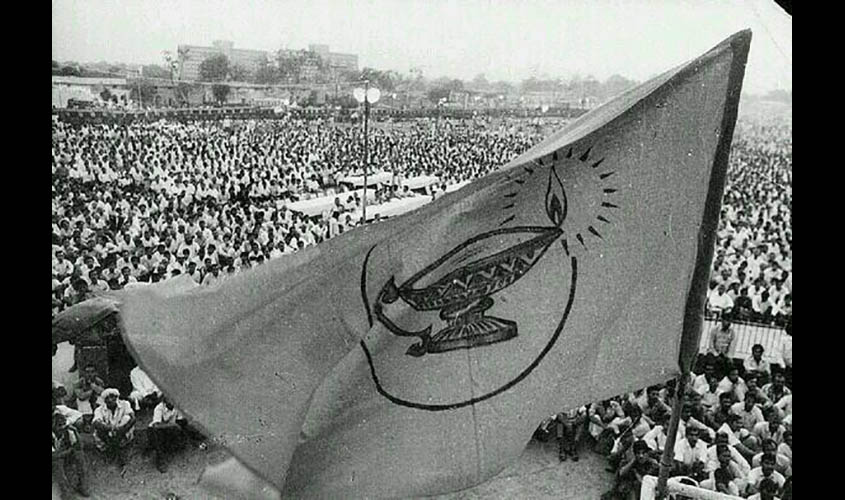Gujarat has long been regarded as the modern day political laboratory, where the Rashtriya Swayamsevak Sangh conducted its first experiments of successfully pushing Hindutva as an electoral apparatus. The BJP, which is the political arm of the Sangh, has been the major beneficiary of the Hindutva mantra, and therefore it is not surprising that the party is in power at the Centre as well as more than 20 states. The right-wing tenor of the state was a contributory factor in the saffron brigade’s triumph in Gujarat. Prior to the BJP and its predecessor, the Bharatiya Jana Sangh, the now extinct Swatantra Party, described as the party of the princes, royalty and big business had a sizable presence in the state.
Gujarat holds a unique place in the country’s history as in the mid-1970s it was from here that the first serious agitation, the Navnirman Andolan, against the Congress, and its all powerful leader Indira Gandhi, was spearheaded by students prompted by the Akhil Bharatiya Vidyarthi Parishad. It is the only instance when a popular government, headed by Chimanbhai Patel, had to resign, leading to the dissolution of the Assembly, calling for fresh elections, despite the fact that at one stage the Congress was in an invincible position.
The Navnirman movement was the precursor to the countrywide Jai Prakash Narayan-led agitation against Indira Gandhi. The current Prime Minister, Narendra Modi, then an upcoming ABVP activist, acquired his political spurs during this period, as also did Arun Jaitley, the then dynamic president of the Delhi University Students’ Union, who by expressing solidarity with the students in Gujarat made his interest in national politics evident. Subsequently, Gujarat became a political sanctuary for top leaders. In 1991, L.K. Advani, after barely scraping to victory against cine super star Rajesh Khanna from New Delhi looked towards Gandhi Nagar to provide him electoral security. Incidentally, for a brief period in the mid 1990s, Atal Behari Vajpayee also represented Gandhi Nagar.
However, the real story of the Sangh’s expansion commenced from the national capital after the formation of the Jana Sangh on 21 October 1951. Delhi was flooded with swarms of Punjabi refugees, who had to leave their homes and hearth in West Punjab, after the tragic partition of India. Their story of struggle from virtual penury to subsequent success coincided with the rise of the Jana Sangh’s influence. By and large, the refugees never forgave the Congress for agreeing to the division of India, which led to an unprecedented migration and the slaughtering of lakhs of people, in one of the most horrific communal carnage ever witnessed.
Both Shyama Prasad Mookerjee and Bal Raj Madhok, who founded the Jana Sangh, were well aware of the ground realities when they began their political operation, which was actively aided and supported by the refugees. It is not a mere coincidence that Vijay Kumar Malhotra, former Chief Executive Councillor of Delhi, and an ex-MP, is perhaps the senior most politician from the Sangh stable, having contested his first election in the early 1950s with the patronage of the Jana Sangh. This was much before Vajpayee and Advani arrived on the scene, and among others who similarly fought on the Jana Sangh ticket was the former Vice President, the late Bhairon Singh Shekhawat.
Malhotra, like every Jana Sangh Punjabi leader, was a protégé of Madhok and thus was swayed by his politics. In fact, the first major political victories scored by the Jana Sangh were from Delhi when in 1967 it secured six out of seven Parliamentary seats and went on to dominate both the Metropolitan Council and the Municipal Corporation. Bal Raj Madhok, who in 1961 had emerged victorious from New Delhi in a byelection, led the charge and once again won from South Delhi. Others, who along with him entered the fourth Lok Sabha were Professor Manohar Lal Sondhi, Hardyal Devgun, Ram Swarup Vidyarthi, Ram Gopal Shawlwale and Kanwar Lal Gupta. However, Chaudhury Mir Singh lost to Chaudhury Brahm Prakash from Outer Delhi.
After that there was no stopping the Jana Sangh. Kidar Nath Sahani, the late Balraj Khanna, Madan Lal Khurana, Lala Hansraj Gupta, Shiv Narain Sarsoonia, Kalka Dass and Charti Lal Goel all were among the stalwarts who dominated the political scenario. In an attempt to curtail the influence of the Jana Sangh in the 1972 polls to the Metropolitan Council, Indira Gandhi campaigned door-to-door in Patel Nagar, the Sangh bastion, yet was unable to defeat Malhotra from there. The Congress wrested the Metropolitan Council but Malhotra. Khurana, Daljit Tandon and two others, kept the Jana Sangh flag at high mast.
The Hindu Mahasabha and the Arya Samaj, both played a major role in consolidating the Jana Sangh’s grasp over the city. It is another matter that over a period of time, the RSS took over and completely seized the political authority from these outfits as well as its veterans. Vajpayee and Advani, the latter was the Chairman of the Delhi Metropolitan Council, subsequently represented New Delhi in the Lok Sabha. Besides them, Krishan Lal Sharma and Sushma Swaraj were also MPs from Outer Delhi and South Delhi, respectively.
The short point is: Delhi first became the nucleus of Jana Sangh and subsequently BJP politics. Therefore, it is imperative for the survival of the BJP to ensure that its influence remains undiluted in the capital, which presently is tilting heavily towards the Aam Aadmi Party (AAP). Between us.

